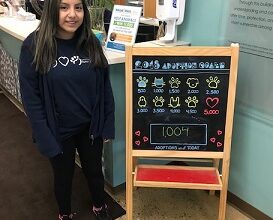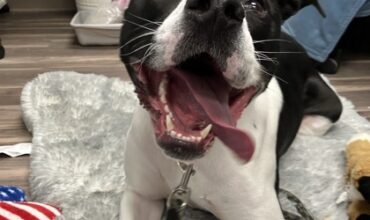Skylar (formerly Iguanadon) was a Love Train puppy. She is enjoying her cat brother, and he seems to enjoy her, too! She is having so much fun getting socialized with her dog aunts and cousins! It’s easy to tell she’s a very happy puppy! Iguanadon now Skylar
Read More
Posts by Wendy Welch
A Bunny Tale
My fiancé and I adopted Posie on New Year’s Eve two years ago. I noticed her in the ‘Adoptable Animals’ and saw that she was not adopted month after month. We went in to visit her, and were told that people were afraid to handle her. Her nickname was the Tiny Terror! She weighs a pound and a half but drew blood regularly. She let me stroke her tiny nose and that’s when I knew I was in love. We brought her home the same day. Now her demeanor has totally changed. She is the sweetest little cuddlebug! She loves
Read More
Strong Sister
The entire Lemmink family wants to thank HSHV for helping save Primrose’s (Fleek) life. She came in on the 1/26/18 Love Train. She became ill and with the help of HSHV she fully recovered and is loving being a “little sister”. Prim is doing great and Jack (Napoleon HSHV rescue) loves her! Primrose now Fleek
Read More
Rosa: Gifts from Bat Mitzvah
Rosa is a junior volunteer at HSHV. She loves animals, enjoys volunteering and wanted to do something special for the dogs and cats of HSHV. Rosa’s center pieces for her Bat Mitzvah were the perfect donation to the humane society. Thank you Rosa!
Read More
Hope: Celebrating in style
For Hope’s 10th birthday she wanted to do something different. Instead of getting gifts from friends, Hope asked her friends to bring donations for the animals of HSHV. She says, “I love puppies and wanted to help animals that need homes!” Thank you so much Hope for your donation of food, beds, treats gifts cards and kitty litter!
Read More
Simon: Birthday gifts for animals
Simon recently celebrated his 11th birthday. Instead of asking for gifts, he asked friends and family to either donate online or in person to HSHV. He donated blankets, toys, food, beds and money for the animals. Thank you so much, Simon!
Read More
Wonderful Addition to the Family!
Since finding her furever home with our family over a year ago, Aurora has snuggled her way onto our laps and into our hearts! She is incredibly smart. She knows her toys: QueeK QueeK (the mouse), Potty Mouse (the catnip mouse that she often sits on), crinkly ball, pink ball, etc. She has also been known to bring them upon request. Aurora has a discerning palate, and truly seems to enjoy ginger broccoli — and to my chagrin — lemon-lime cookies that I left on the counter in a plastic Ziploc baggie! (Won’t do that again!) Aurora loves her sporadic
Read More
The Ann Arbor’s 107one Pet-of-the-week is Feta!
Feta is the Ann Arbor's 107one Pet of the Week!
Read More
The WTKA Top-Dog-of-the-Week is Ladybug!
Ladybug is the WTKA Top Dog of the Week!
Read More
The Lucy Ann Lance Show Pet-of-the-Week is Monkey!
Monkey is the Lucy Ann Lance Show pet of the week!
Read More













